Ice Station Zebra Blu-ray Movie
HomeIce Station Zebra Blu-ray Movie 
Warner Bros. | 1968 | 149 min | Rated G | Oct 09, 2012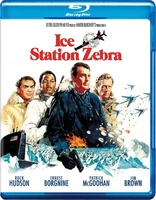
Movie rating
6.9 | / 10 |
Blu-ray rating
| Users | 4.6 | |
| Reviewer | 3.0 | |
| Overall | 3.7 |
Overview
Ice Station Zebra (1968)
A U.S. Naval submarine team races the Soviets to a remote outpost in the North Pole to recover some top-secret satellite photography.
Starring: Rock Hudson, Ernest Borgnine, Patrick McGoohan, Jim Brown, Tony BillDirector: John Sturges
| Thriller | Uncertain |
| Drama | Uncertain |
| Action | Uncertain |
Specifications
Video
Video codec: MPEG-4 AVC
Video resolution: 1080p
Aspect ratio: 2.19:1
Original aspect ratio: 2.20:1
Audio
English: DTS-HD Master Audio 5.1 (48kHz, 24-bit)
French: Dolby Digital 2.0
Spanish: Dolby Digital Mono
Subtitles
English SDH, French, Spanish
Discs
50GB Blu-ray Disc
Single disc (1 BD)
Playback
Region free
Review
Rating summary
| Movie | 2.5 | |
| Video | 4.5 | |
| Audio | 4.0 | |
| Extras | 1.0 | |
| Overall | 3.0 |
Ice Station Zebra Blu-ray Movie Review
Ever get that sinking feeling?
Reviewed by Jeffrey Kauffman October 7, 2012I grew up in the mountains outside of Salt Lake City and my parents’ house had a rather precipitous rock strewn cliff
that rose up next to our driveway. When I was probably eight or nine a buddy of mine came over to play and started
laying out a scenario of us being “good guy” Americans who had to climb the rock wall to take a "German fortress" that
was supposedly at the top of the cliff. He looked straight at me and told me the name of the game was The Guns of
Navarone. Now I was young and wasn’t especially tuned in to either the literary or cinematic world at that age and
didn’t realize at the time that he had obviously seen the movie on television (probably the night before) and was acting
out what he had just witnessed. I however thought that the game’s name was really weird sounding, and some time
later, when I did become aware of the film, everything clicked into place and I had a hearty laugh. Years later
as a kind of geeky teenager I joined a book club and started reading a lot of Alistair MacLean’s novels. I found them
brisk and exciting, with some nice tangential historical elements and some great set pieces. MacLean had his first brush
with major mainstream prominence with The Guns of Navarone, and once the film adaptation proved to be such
an overwhelming success, his books became hot properties in Hollywood. While 1965’s The Satan Bug had a
rather tenuous connection to its MacLean source novel, it took until 1968, some seven years after The Guns of
Navarone debuted in theaters, for another big budget action adventure film based on a best selling MacLean novel
to hit the screen.
While this adaptation too strayed from MacLean’s original conception, Ice Station Zebra
attempted to blend some of the action adventure elements of The Guns of Navarone with the espionage
environment of The Satan Bug. The film might have worked as a smaller scale psychological thriller, but
someone at MGM decided this was the perfect property for what was then already a dying breed, the big budget
roadshow engagement. Ice Station Zebra was marketed as the “big” MGM picture of the year, while another
MGM attraction that was initially derided but soon applauded as an all-time classic, 2001: A Space Odyssey,
turned out to be the film everyone was talking about. (In many markets, MGM attempted to draw people to Ice
Station Zebra after its roadshow engagements by exhibiting it in a double feature with 2001: A Space
Odyssey, certainly not a match
made in theatrical heaven.) Ice Station Zebra is kind of a lumbering behemoth of a film, way too big for its own
good, That said, it has an effective opening act that at least partially makes up for a lethargic denouement that plays
more like filler than thriller.
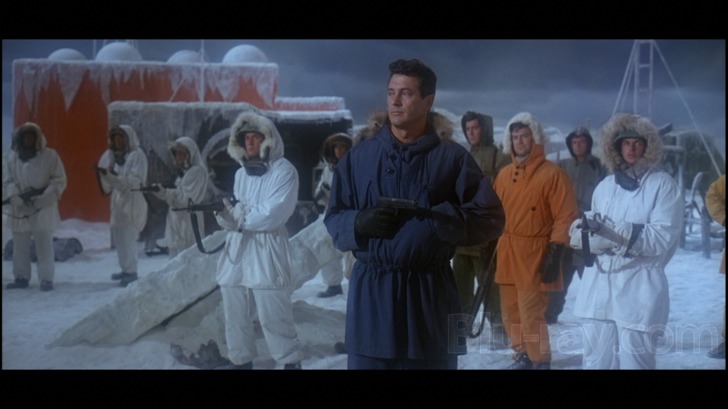
Ice Station Zebra actually gets off to an exciting enough start, as we see a satellite of some sort making its reentry into the Earth’s atmosphere with a coterie of international military types tracking its descent. It touches down in an Arctic wilderness and a heavily coated individual moves to it to retrieve something, not noticing that there’s someone following him. We segue quickly to Scotland, where Commander Ferraday (Rock Hudson) of the nuclear submarine USS Tigerfish is summoned to a private meeting with an admiral (Lloyd Nolan) where he’s told he is about to command a rescue mission to the so-called Ice Station Zebra, a research station that floats with the ice pack and which has been sending out distress signals for several days. Though the admiral doesn’t completely come clean about it, he indicates that there’s another real reason the mission is being launched, and to handle that aspect of the outing, he’ll be taking a special passenger on board.
That passenger turns out to be a prickly British gentleman perhaps pseudonymously called Mr. Jones (Patrick McGoohan). There’s little disguising the contempt that Jones and Ferraday feel for each other, and Jones makes no bones in making it quite clear that he’s in charge of the mission even though Ferraday is the putative Captain of the submarine. There’s an interesting if unintentional similarity to that “other” 1968 spectacular from MGM, 2001: A Space Odyssey, in this general setup. In both films we have a mission shrouded in secrecy whose commander is only dimly aware of the real reason the mission has been set into motion.
A marine contingent is rather strangely put onto the sub and then two additional passengers are flown in, Anders (Jim Brown) and Vaslov (Ernest Borgnine). Vaslov is a former Soviet agent who has defected to the West and who is a long time collaborator with Jones. So far, so good. We have a great cast of interesting characters, an intriguing enough concept that leaves the audience guessing about what’s really going on, and a high tech military setting that includes a lot of (literal) bells and whistles in a nuclear submarine. And the first hour or so of Ice Station Zebra makes the most of all of these elements.
There are some fantastic set pieces in this opening act which include the submarine trying to find out exactly where Ice Station Zebra might be (since it floats with the ice pack), a disastrous accident that seems to be the result of sabotage, and, right before intermission (this being a roadshow engagement, after all), the sub finally managing to crack through the ice pack to hopefully complete its mission, whatever that might be. But then things begin to go horribly, horribly wrong. We’ve already been led to believe that there’s a spy on board, courtesy of the “accident” which seems anything but. The suspects are really limited to Jones, Anders or Vaslov, and the writing here is not nuanced enough to make the eventual denouement much of a surprise.
More problematic is the film’s ridiculously lethargic second act, which sees the bulk of the action playing out on obvious studio sets designed to approximate the frozen Arctic wilderness. Once the real reason for the mission comes to light, many are probably going to be asking in disbelief, “That’s it?”, and that disbelief isn’t just the result of a 21st century cynicism—my hunch is audiences in 1968 were probably just as incredulous. The film devolves into a showdown between those nefarious Russkies and the stalwart Americans, and if there’s a bit of political nuance that actually creeps into the screenplay, it’s clad in an overall “us vs. them” scenario that undercuts any attempt at shades of gray.
If Ice Station Zebra had simply been judiciously trimmed, it might have been one of the biggest blockbusters of the late sixties. As it stands, it seems to be one of the best examples of the major studios attempting—in vain—to recapture the glory days of old with big budget epics that simply didn’t have the intrinsic elements to support the gargantuan productions. There’s really nothing inherently horrible about Ice Station Zebra and the first half of the film is a surprisingly brisk and exciting entertainment. There’s an old adage in the legitimate theater about “second act problems” and that’s pretty much exactly what the issue with Ice Station Zebra is. The problem is when a film reaches its conclusion, it’s that second act that’s most vividly in the audience’s mind, while the first act is already beginning to fade into the cold Arctic mist.
Ice Station Zebra Blu-ray Movie, Video Quality 
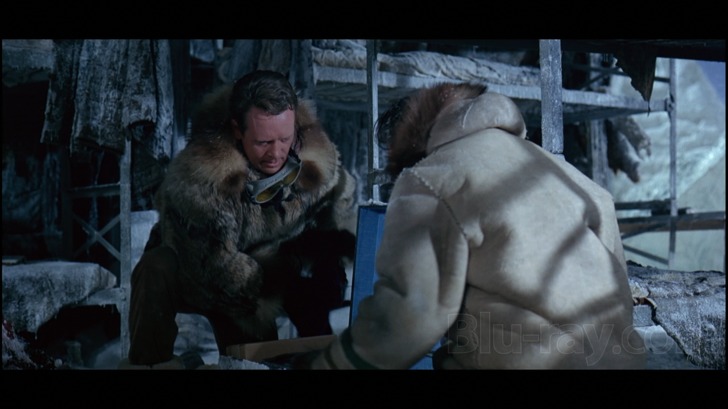
Ice Station Zebra is presented on Blu-ray courtesy of Warner Brothers with an AVC encoded 1080p transfer in 2.19:1. This Super Panavision 70 feature looks fantastically sharp and well detailed on Blu-ray, as most of these larger format features usually do. Colors are beautifully saturated and robust, and the image has a startling clarity that benefits from extremely good contrast and solid black levels. This high definition presentation does reveal some of the "seams" of the special effects (the opening sequence featuring the satellite suffers, especially in the scene where it parachutes into the clouds), and some of the underwater photography, while undeniably impressive, is understandably softer and less detailed than the "surface level" sequences. Despite the many scenes featuring blizzard like conditions, there are no issues with the image not resolving correctly.
Ice Station Zebra Blu-ray Movie, Audio Quality 
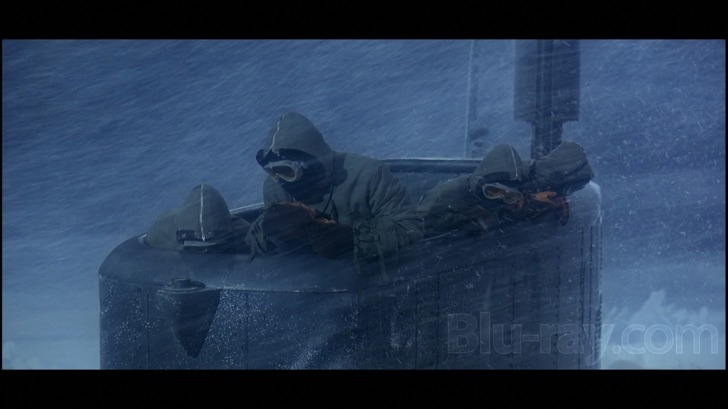
Ice Station Zebra features a lossless DTS-HD Master Audio 5.1 mix that presents Michel Legrand's boisterous score in all its majextic beauty. The surround activity here is kind of interesting, in that so much of the film (at least in the first half) takes place in the enclosed confines of the nuclear submarine, so instead of incredibly immersive activity, we're instead offered very nicely albeit pretty subtly placed effects, with a radar "blip" on the left channel or the sound of an engine rumbling through the rear channels. Things open up considerably in the arctic second half, where the storm sounds whip through the surrounds quite convincingly. There is quite a bit of LFE on display here, including an explosion or two and a couple of incidents of gunfire. Dialogue is cleanly and clearly presented and the mix is extremely well prioritized.
Ice Station Zebra Blu-ray Movie, Special Features and Extras 
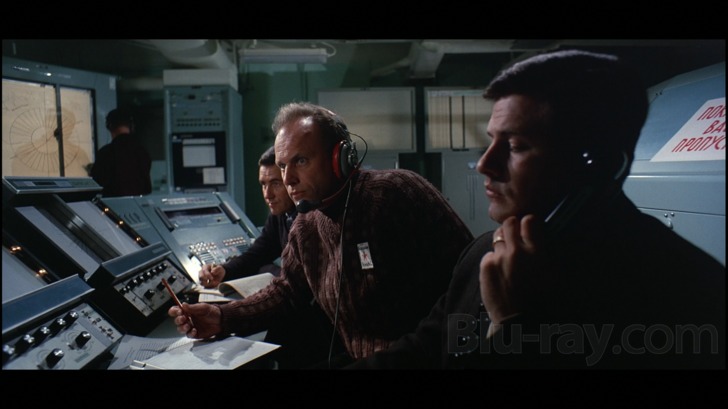
- The Man Who Makes the Difference (SD; 7:14) is a vintage featurette about John Stephens, Second Unit photographer. There's some fantastic footage here showing Stephens' innovations in capturing everything from skiers at Sun Valley to the great races in Grand Prix. Stephens also invented a gyro mount that was sort of precursor to today's Steadicam.
- Theatrical Trailer (SD; 2:39)
Ice Station Zebra Blu-ray Movie, Overall Score and Recommendation 

Ice Station Zebra is one of those "glass half full, glass half empty" situations (with or without ice cubes). The first half or so of the film is exciting, well paced and features well drawn characters and good plot machinations. But once we get to those studio bound arctic sets, everything melts into a pretty sickly puddle, like an ice floe under the assault of global warming. Fans of the film (and there are many) will no doubt love this Blu-ray's superior video and audio, and for them I certainly heartily recommend this release. For the public at large, though, this is better seen as a perfect symbol of a dinosaur somehow showing up when its big budget roadshow engagement kin had largely become extinct.
Similar titles
Similar titles you might also like

Raise the Titanic
1980

Where Eagles Dare
1968

Telefon
1977

Operation Crossbow
The Great Spy Mission / Warner Archive Collection
1965

The Peacemaker 4K
1997

The Hunt for Red October 4K
1990

Blue Thunder
1983

The Chairman
Limited Edition
1969

Phantom
2013

Pork Chop Hill
1959

The Ipcress File
1965

The Sea Chase
Warner Archive Collection
1955

The Quiet American
Limited Edition to 3000
1958

Child 44
2014

Morituri
Saboteur: Code Name Morituri | Limited Edition to 3000
1965

Billion Dollar Brain
1967

Run Silent, Run Deep
Special Edition
1958

Anna
2019

The Fourth War
1990

American Assassin
2017